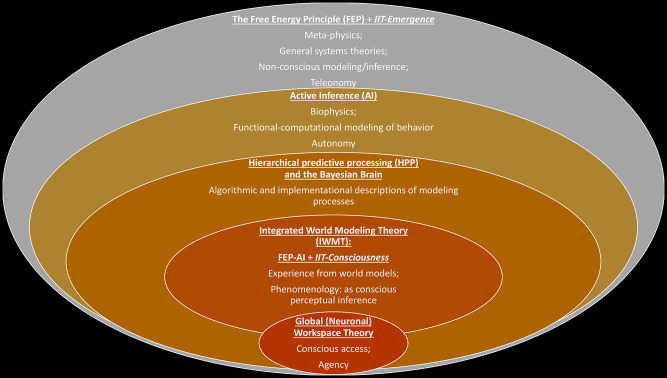Figure 1.
Intersections between FEP-AI, IIT, GNWT, and IWMT.
The Free Energy Principle (FEP) constitutes a general means of analyzing systems based on the preconditions for their continued existence via implicit models. Integrated Information Theory (IIT) provides another general systems theory, focused on what it means for a system to exist from an intrinsic perspective. The extremely broad scope of FEP-AI and IIT suggests (and requires for the sake of conceptual consistency) substantial opportunities for their integration as models of systems and their emergent properties. Within the FEP (and potentially within the scope of IIT), a normative functional-computational account of these modeling processes is suggested in Active Inference (AI). Hierarchical predictive processing (HPP) provides an algorithmic and implementational description of means by which systems may minimize prediction error (i.e., free energy) via Bayesian model selection in accordance with FEP-AI. Particular (potentially consciousness-entailing) implementations of HPP have been suggested that involve multi-level modeling via the kinds of architectures suggested by Global Neuronal Workspace Theory (GNWT). The concentric circles depicted above are intended to express increasingly specific modeling approaches with increasingly restricted scopes. (Note: These nesting relations ought not be over-interpreted, as it could be argued that HPP does not require accepting the claims of FEP-AI.) This kind of generative synthesis may potentially be facilitated by developing an additional version of IIT, specifically optimized for analyzing systems without concern for their conscious status, possibly with modified axioms and postulates: IIT-Consciousness (i.e., current theory) and IIT-Emergence (e.g., alternative formulations that utilize semi-overlapping conceptual-analytic methods). Integrated World Modeling Theory (IWMT) distinguishes between phenomenal consciousness (i.e., subjective experience) and conscious access (i.e., higher-order awareness of the contents of consciousness). Non-overlap between the circle containing GNWT and the circle containing IIT-Consciousness is meant to indicate the conceivability of subjectivity-lacking systems that are nonetheless capable of realizing the functional properties of conscious access via workspace architectures. IWMT is agnostic as to whether such systems are actually realizable, either in principle or in practice.

